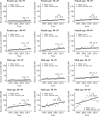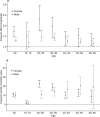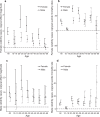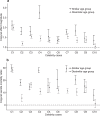Age and sex subgroups vulnerable to copycat suicide: evaluation of nationwide data in South Korea
- PMID: 31754190
- PMCID: PMC6872728
- DOI: 10.1038/s41598-019-53833-8
Age and sex subgroups vulnerable to copycat suicide: evaluation of nationwide data in South Korea
Abstract
Media reports of a celebrity's suicide may be followed by copycat suicides, and the impact may vary in different age and sex subgroups. We proposed a quantitative framework to assess the vulnerability of age and sex subgroups to copycat suicide and used this method to investigate copycat suicides in relation to the suicides of 10 celebrities in South Korea from 1993 to 2013. By applying a detrending model to control for annual and seasonal fluctuations, we estimated the expected number of suicides within a copycat suicide period. The copycat effect was assessed in two ways: the magnitude of copycat suicide by dividing the observed by the expected number of suicides, and the mortality rate by subtracting the expected from the observed number of suicides. Females aged 20-29 years were the most vulnerable subgroup according to both the magnitude of the copycat effect (2.31-fold increase over baseline) and the mortality rate from copycat suicide (22.7-increase). Males aged 50-59 years were the second most vulnerable subgroup according to the copycat suicide mortality rate (20.5- increase). We hope that the proposed quantitative framework will be used to identify vulnerable subgroups to copycat effect, thereby helping devise strategies for prevention.
Conflict of interest statement
The authors declare no competing interests.
Figures




Similar articles
-
The impact of indiscriminate media coverage of a celebrity suicide on a society with a high suicide rate: epidemiological findings on copycat suicides from South Korea.J Affect Disord. 2014 Mar;156:56-61. doi: 10.1016/j.jad.2013.11.015. Epub 2013 Dec 1. J Affect Disord. 2014. PMID: 24355649
-
Copycat Suicide Induced by Entertainment Celebrity Suicides in South Korea.Psychiatry Investig. 2016 Jan;13(1):74-81. doi: 10.4306/pi.2016.13.1.74. Epub 2015 Oct 19. Psychiatry Investig. 2016. PMID: 26766949 Free PMC article.
-
The effects of celebrity suicide on copycat suicide attempt: a multi-center observational study.Soc Psychiatry Psychiatr Epidemiol. 2012 Jun;47(6):957-65. doi: 10.1007/s00127-011-0403-7. Epub 2011 Jun 8. Soc Psychiatry Psychiatr Epidemiol. 2012. PMID: 21656079 Clinical Trial.
-
Media coverage as a risk factor in suicide.Inj Prev. 2002 Dec;8 Suppl 4(Suppl 4):IV30-2. doi: 10.1136/ip.8.suppl_4.iv30. Inj Prev. 2002. PMID: 12460954 Free PMC article. Review.
-
Media coverage as a risk factor in suicide.J Epidemiol Community Health. 2003 Apr;57(4):238-40. doi: 10.1136/jech.57.4.238. J Epidemiol Community Health. 2003. PMID: 12646535 Free PMC article. Review.
Cited by
-
High-Risk Suicide Locations in Australia.JAMA Netw Open. 2024 Jun 3;7(6):e2417770. doi: 10.1001/jamanetworkopen.2024.17770. JAMA Netw Open. 2024. PMID: 38900425 Free PMC article.
-
The Werther effect of celebrity suicides: Evidence from South Korea.PLoS One. 2021 Apr 28;16(4):e0249896. doi: 10.1371/journal.pone.0249896. eCollection 2021. PLoS One. 2021. PMID: 33909657 Free PMC article.
-
Raising awareness of suicide prevention during the COVID-19 pandemic.Neuropsychopharmacol Rep. 2020 Dec;40(4):392-395. doi: 10.1002/npr2.12141. Epub 2020 Oct 6. Neuropsychopharmacol Rep. 2020. PMID: 33022901 Free PMC article. Review.
-
Copycat in Suicide: A Systematic Review of the Literature.J Clin Med. 2024 Nov 25;13(23):7118. doi: 10.3390/jcm13237118. J Clin Med. 2024. PMID: 39685577 Free PMC article. Review.
References
-
- WHO. Global Health Observatory (GHO) data (2016).
-
- OECD. Suicide rates, https://data.oecd.org/healthstat/suicide-rates.htm (2017).
-
- KOSTAT. Causes of Death Statistics 2018, http://kostat.go.kr/portal/korea/kor_nw/1/6/2/index.board?bmode=read&... (2019).
-
- Dwivedi, Y. The neurobiological basis of suicide. (Taylor & Francis/CRC Press, 2012). - PubMed
MeSH terms
Grants and funding
LinkOut - more resources
Full Text Sources
Medical

